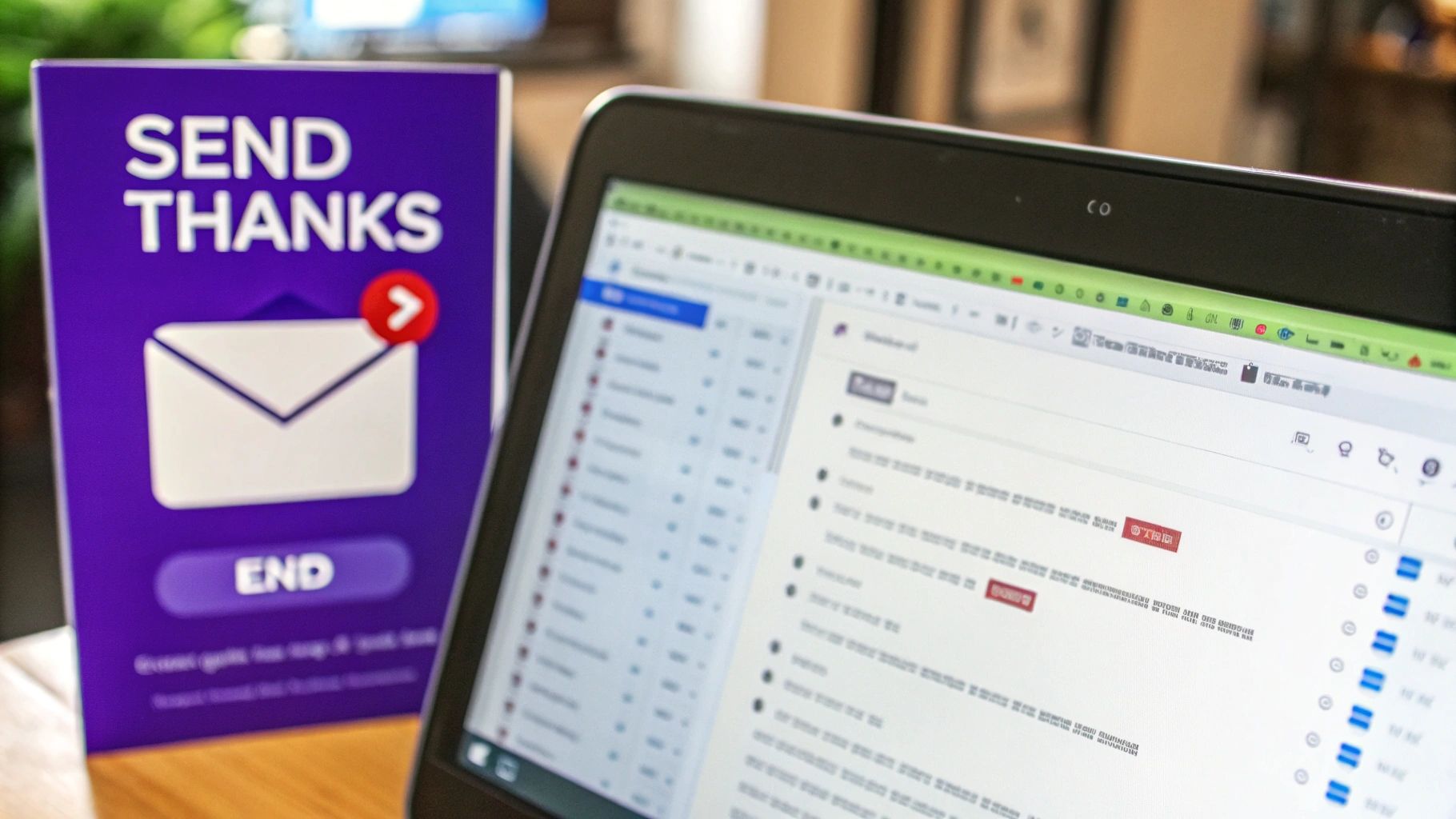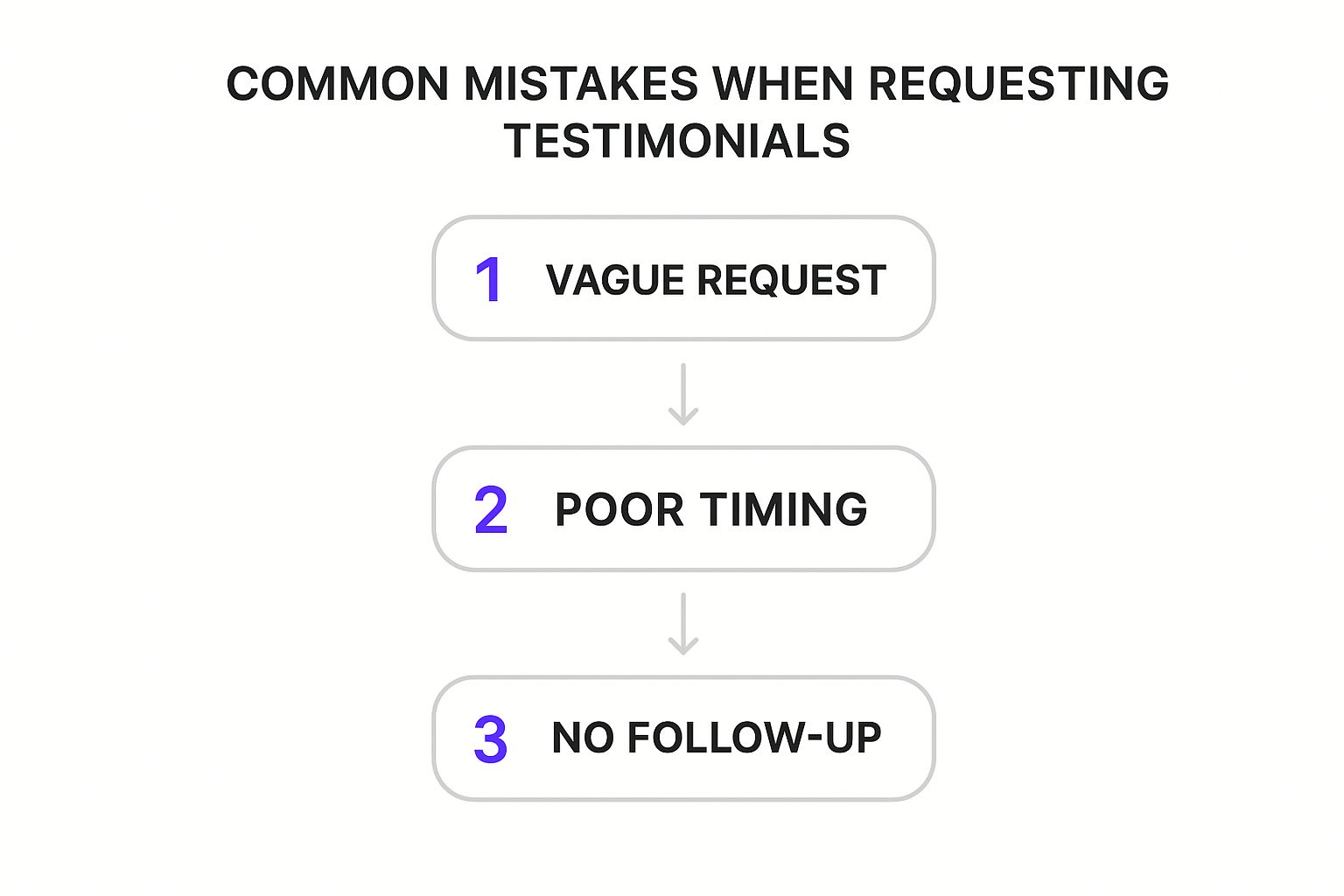How to Request a Testimonial That Drives Conversions
Master how to request a testimonial with proven strategies that get results. Learn timing, approach, and follow-up tactics that turn customers into advocates.
Posted by
The Psychology Behind Saying Yes: Why Your Approach Matters
Ever wonder why most of your testimonial requests get crickets? It's usually because your ask feels like a chore. When you ask a happy customer for a "favor," you're just adding another task to their already packed to-do list. The real secret to getting an excited "yes" is to stop asking for favors and start giving them a platform to celebrate their own success.
From Asking a Favor to Offering an Opportunity
The best brands don't just ask for reviews; they create a space where customers feel seen and appreciated. Your happiest clients are genuinely proud of what they’ve accomplished with your product or service. When you ask for a testimonial, you’re giving them a chance to be the hero of their own story. This simple shift in mindset turns a boring request into a genuine, relationship-building moment.
Here’s how to put this into practice:
- Put the spotlight on their success. Instead of a generic, "Can you leave a review?" try something like, "Your results have been incredible, and we'd love to showcase your success story."
- Frame it as helping others. Let them know their experience could be the guide someone else needs to solve a similar problem.
- Make them the main character. Be clear that you want to feature them and their unique journey, not just grab a quick quote for your homepage.
The Real Impact of Their Story
This approach is so effective because people fundamentally trust their peers. When a customer shares their story, they aren't just doing you a solid—they're adding to a community of trust that other buyers depend on. It’s no surprise that a staggering 92% of customers read online reviews before making a purchase.
This reliance is a powerful motivator. Research shows that 88% of consumers say reviews influence their online decisions, and 72% feel that positive testimonials make them trust a business more. You can discover more about the power of testimonials and see how deep this trust runs.
Getting the psychology right is the first step. As you build a system around this, it helps to see how others are already managing their social proof. For some great inspiration, check out how other companies collect and feature their customer Reviews.
Timing Your Request for Maximum Success
 Okay, you've got the right mindset for asking. But the next piece of the puzzle is just as important: timing. Asking for a testimonial at the wrong moment is like interrupting someone mid-sentence—it’s awkward and rarely gets you what you want. The real secret is to pop the question when your customer’s happiness is at an all-time high, capturing their fresh enthusiasm.
Okay, you've got the right mindset for asking. But the next piece of the puzzle is just as important: timing. Asking for a testimonial at the wrong moment is like interrupting someone mid-sentence—it’s awkward and rarely gets you what you want. The real secret is to pop the question when your customer’s happiness is at an all-time high, capturing their fresh enthusiasm.
Identifying the Golden Moments
The good news is, these moments of peak satisfaction aren't random. They happen at predictable points in the customer journey, and you just need to know what to look for. Instead of guessing, start watching for key events that signal a happy client who is ready to sing your praises.
These are the moments you're looking for:
- Right After a Big Win: Did your client just hit a major goal using your software? Or maybe they just signed off on a project deliverable they absolutely love. That's your cue. Their success is fresh in their mind, and they’re feeling great about their decision to work with you.
- Following Spontaneous Praise: If a customer sends you an email out of the blue that says, "Wow, this is amazing!"—that's a huge green light. Your immediate reply should be something like, "That's fantastic to hear! Would you be open to sharing that experience in a quick testimonial?"
- At the End of a Project: For anyone in a service-based business, the moment a project is successfully wrapped up is a perfect time to ask. The entire positive experience is still vivid, making it easy for them to recall specific details.
Your Industry Changes the Timing
Of course, the "perfect" time really depends on your business. If you run a digital agency, asking for a review right after launching a client's successful campaign makes perfect sense. But if you sell skincare, you'll want to wait 30-60 days after the purchase. You have to give the product enough time to actually deliver results.
The main idea is always the same: align your request with the moment your customer feels they've gotten the most value. This is a core part of figuring out how to request a testimonial that feels natural and not pushy.
By creating a simple system to track these moments, you make your timing feel respectful and thoughtful. When you care about their experience, they're more likely to share it. For more ideas, check out these strategies to improve customer satisfaction to make sure every request lands perfectly.
Crafting Requests That Feel Genuine, Not Sales-y

Let's be honest, we all know that email. The one with a subject line like "A Quick Favor?" that immediately feels like a generic marketing blast. A "Please leave us a review" message is easy to delete because it’s impersonal and makes the customer feel like a number. The secret to getting a great response is to make your request a real conversation that respects the relationship you've already built.
It's all about making your customers feel seen and appreciated, not just used for a marketing asset.
Personalize Your Ask Around Their Win
The most powerful requests are built on specifics. Vague praise gets forgotten, but a specific compliment proves you're actually paying attention. Instead of a broad prompt, bring up their actual success story.
For example, a consultant wouldn't just send a follow-up saying, "Hope you liked our work!" A much better approach would be:
"Hi Jane, I was just looking at your team's project board and saw you've already completed two sprints ahead of schedule since we implemented the new workflow. That’s incredible! We’d be thrilled if you’d be willing to share a bit about that experience."
This strategy works for any business. An e-commerce store could send a message saying, "Hi Mark, we saw your photos on Instagram with the new camera lens—they look amazing! Would you mind sharing a quick thought on how it's improved your landscape shots?" This simple change shows you see them as an individual, not just an order number.
So, which approach is right for you? It often depends on your relationship with the customer and how much time you can invest. Here’s a quick breakdown of different ways to ask:
Testimonial Request Approaches Comparison
| Request Method | Success Rate | Best For | Time Investment |
|---|---|---|---|
| Personalized Email | High (~60-70% response) | High-value clients, B2B services, specific success stories. | Medium (Requires research on the client's win) |
| Automated Pop-Up/Survey | Low (~5-15% response) | E-commerce, SaaS, collecting a high volume of general feedback. | Low (Set it and forget it) |
| In-Person/Video Call Ask | Very High (~80%+ response) | Key accounts, long-term partners, post-project wrap-ups. | High (Requires scheduling and direct interaction) |
| Social Media DM | Medium (~30-40% response) | Customers who've tagged you, influencers, active community members. | Medium (Requires monitoring and quick, casual outreach) |
The main point here is that higher-effort, personalized requests yield much better results. While automated methods have their place for scaling up, nothing beats a genuine, specific ask made to the right person at the right time.
Frame It as an Opportunity to Help Others
Think about it: people love to share advice and help others who are facing a challenge they've already overcome. By framing your request as a chance for them to guide someone else, you give their story a bigger purpose. Instead of asking them to help your brand, ask them to help people like them.
You could say something like, "Your story about overcoming [specific challenge] could really inspire other small business owners who are struggling with the same thing." This gives their testimonial a mission beyond just promoting your company; it becomes a piece of valuable advice.
This small shift in language makes a huge impact. There are many ways to phrase these questions, and you can find more script ideas in our article about how to ask for testimonials. The goal is to make the request specific while leaving room for their authentic voice to shine through.
Choosing the Right Testimonial Format for Your Goals
Not all testimonials are created equal. A quick quote might be perfect for your pricing page, but a detailed video story could be what closes a major deal. The key is matching the format to your goal and understanding where your customer is in their journey.
When to Go for a Classic Written Quote
Imagine you need to quickly add some social proof to your website or a new email campaign. This is where written testimonials are incredibly useful. They’re concise, punchy, and perfect for highlighting a specific feature or a standout result.
Because they are just text, they’re super easy to drop onto product pages, into email signatures, or anywhere you need a quick hit of credibility. Plus, they’re a low-effort ask for your busy customers, which means you can collect a bunch of them without asking for too much time.
Using Video to Build Real Connection
When your goal is to build genuine trust, video is your best friend. There’s something powerful about seeing a real person share their story—their challenges, their solution, and their success. In fact, research shows 2 out of 3 people say they’re more likely to buy after watching a testimonial video that shows how a similar person succeeded. You can discover more insights on this here.
The trick is making the process painless. By guiding your customers with simple prompts and offering support, you help them forget the camera and just speak from the heart. Getting the request right is half the battle, and it helps to review different strategies for how to Leverage Recommendations and Endorsements on Linkedin.
Creating a Mix-and-Match Testimonial Strategy
You don’t have to pick just one format. The smartest approaches use a mix of testimonials to serve different purposes. This table breaks down where each format shines.
| Format | Best For | Effort Level | Ideal Length |
|---|---|---|---|
| Written | Broad audience | Low | 1–2 sentences |
| Video | High-touch stories | Medium | 30–90 seconds |
| Case Study | Detailed results | High | 300+ words |
Think of it this way: you can sprinkle short written quotes on landing pages for immediate social proof, then use your powerful video stories in sales decks or on a dedicated customer success page.
If you're stuck on what to say when you ask, our guide on sample business testimonial letters offers great prompts. Here’s a final tip: when you send your request, include a simple checkbox allowing customers to pick either a written or video format. Just providing clear guidelines and options can boost completion rates by an impressive 30%.
Removing Every Barrier to Make Participation Effortless
The number one killer of a great testimonial isn't a shy customer. It's friction. Let's be real—your customers are busy. Even if they absolutely love your product, a confusing or time-consuming request will always end up at the bottom of their to-do list. The goal is to make saying "yes" so simple they can do it in just a few minutes.
Make It Simple from the Start
Stop sending vague requests. Asking a customer, "Can you write us a testimonial?" is like handing them a blank page and hoping for a masterpiece. It's intimidating. Instead, you need to guide them with questions that trigger great stories. This removes the mental work of figuring out what to write.
Try asking questions that spark a memory, like:
- What was the biggest challenge you had before you found us?
- Can you tell us about the moment you knew this was the right choice for you?
- What’s a specific result you've achieved that you're really proud of?
These kinds of prompts do the hard work for your customer, making it easy for them to give you the powerful, detailed stories you’re looking for.
Offer Flexible Submission Options
Not everyone wants to be a movie star, and that’s okay. Some customers will happily record a quick video on their phone, while others would much rather type out a few sentences. To get the best results, you have to meet them where they are.
When you send your request, give them options. Let them know they can reply directly to the email, fill out a simple form, or click one link to record a short video. This is exactly why a tool like EndorseFlow is so powerful—it lets you create a single, easy-to-use link where customers can choose how they want to share their story.
By showing you respect their time and preferences, you don't just get more responses; you get more genuine, heartfelt testimonials. This simple act of making it easy is the secret to getting testimonials people actually complete.
Following Up With Grace and Persistence
 Let's be real: you'll rarely get a testimonial on the first try. People are busy, inboxes are overflowing, and your request can easily slip through the cracks. This is where a smart follow-up strategy comes into play. The goal isn't to nag but to be a friendly, persistent reminder. A big part of learning how to request a testimonial is mastering the art of the polite nudge.
Let's be real: you'll rarely get a testimonial on the first try. People are busy, inboxes are overflowing, and your request can easily slip through the cracks. This is where a smart follow-up strategy comes into play. The goal isn't to nag but to be a friendly, persistent reminder. A big part of learning how to request a testimonial is mastering the art of the polite nudge.
The Art of the Gentle Nudge
Your follow-up email should never be a simple copy-and-paste of your first message. Each message is a chance to strengthen your relationship, not just repeat a request. Try to add a little something extra that keeps the conversation warm and shows you value them as more than just a potential quote.
Here are a few ways to add value without being pushy:
- Celebrate their wins: "Hey, I saw your company was featured in [Publication]! That’s incredible, congrats! On that note, just wanted to gently bump my previous email about a testimonial."
- Offer a helping hand: "Just checking in on this. If you have any questions at all about the process—what to say, how to record, anything—just let me know. Happy to help!"
- Share something useful: "I came across this article on [relevant topic] and thought you might find it interesting. Also, a quick reminder about the testimonial when you have a free moment."
When to Gracefully Bow Out
Persistence is great, but you also need to know when to call it quits. If you’ve sent two or three polite follow-ups over a few weeks and hear nothing but crickets, it’s probably time to let it go. Your primary goal is to maintain a positive relationship. Pushing too hard can quickly turn a happy customer into an annoyed one, which is the last thing you want.
You might wonder why this effort is so important. The payoff is huge, especially for video. One study found that 72% of marketers see an ROI between 50–500% from their video testimonials because of the direct impact on conversions. When the results are that good, a few thoughtful follow-ups are well worth the time. Explore the full power of video testimonials here.
Your Testimonial Collection System That Actually Works
Let's be real, getting a great testimonial feels amazing. But what if you could stop waiting for those happy accidents and start making them happen on demand? When you combine the right psychology, perfect timing, and a genuine ask, you move from occasionally getting a good quote to building a reliable system.
This approach turns random acts of kindness from customers into a predictable engine for social proof that fuels your growth. It’s how learning how to request a testimonial becomes a core, repeatable part of your customer experience.
Building Your Testimonial Engine
The secret isn't asking everyone. It's about asking the right people at the right time. Instead of blasting your entire email list and hoping for the best, focus your energy on the customers most likely to say yes.
We've found the most enthusiastic advocates usually fall into one of three groups:
- The Recent Winner: This is a customer who just hit a major milestone or had a significant win using your product. Their excitement is contagious, and their story is fresh.
- The Loyal Veteran: This is your long-term client who has been with you for ages. They understand your value on a deep level and can speak to your long-term impact.
- The Spontaneous Fan: This is the person who sends an unsolicited email or leaves a glowing comment. That's a golden ticket—they've already done the hard part for you!
Focusing on these groups shows you respect your customers' time and dramatically increases your chances of getting a powerful, authentic story.
Avoiding Common Pitfalls
Of course, even the best intentions can go wrong. We see a few common mistakes that can derail a testimonial request before it even gets a response. In fact, most failed attempts come down to the same three missteps.

As you can see, these issues are all connected. A vague request often means you've timed it poorly, which makes you less confident to follow up. It’s a vicious cycle that leads to a folder full of missed opportunities.
Tracking and Refining Your Approach
So, how do you know if your system is actually working? You measure it. You don't need a complex analytics dashboard. Just start by tracking a few simple metrics, like your request-to-response rate and your completion rate (the percentage of people who agree and then actually follow through).
To give you a clearer picture, here are some key metrics to track, along with benchmarks for what good (and great) performance looks like.
Testimonial Collection Success Metrics
Key performance indicators and benchmarks for measuring testimonial collection effectiveness
| Metric | Good Performance | Excellent Performance | How to Improve |
|---|---|---|---|
| Request-to-Response Rate | 20-30% | 40%+ | Personalize your outreach; improve your timing; clarify your "why." |
| Completion Rate | 50-60% | 75%+ | Make the submission process frictionless; offer multiple formats (text, video); provide clear prompts. |
| Time to Submission | Within 7 days | Within 3 days | Automate follow-ups; send a gentle reminder 2-3 days after the initial ask. |
| Usable Testimonial Rate | 80% | 95%+ | Guide the customer with specific questions; use a platform that ensures good quality. |
Seeing these numbers in black and white is powerful. Did your response rate jump after you started personalizing subject lines? Did offering video options increase completions? This data-driven feedback loop is the foundation of a strong testimonial marketing strategy.
Now, you could try to build and manage this system manually with spreadsheets and calendar reminders. But that sounds like a full-time job. What if you could automate the entire workflow, from identifying the right moments to sending personalized requests and making submission completely frictionless? That’s exactly what EndorseFlow does. Stop chasing testimonials and start building a hands-free system that brings them to you.